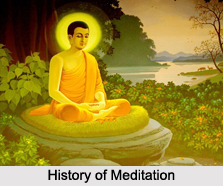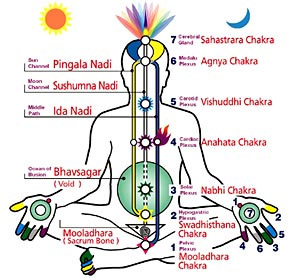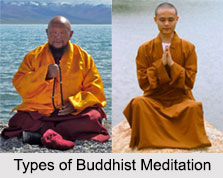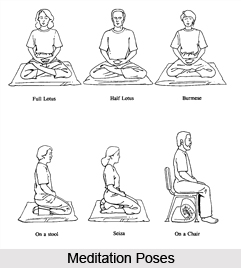 Zen Meditation or Zazen is a concept of seated meditation. Zen Meditation is performed when seated and this is a discipline performed to calm the body and mind and experience insight into the nature of existence. The Zen Buddhists are known as `Meditation.
Zen Meditation or Zazen is a concept of seated meditation. Zen Meditation is performed when seated and this is a discipline performed to calm the body and mind and experience insight into the nature of existence. The Zen Buddhists are known as `Meditation.
Buddhists` and basically the Zazen is the study of self. Originally Zen referred to a sitting practice alone, but now it is widely used to meditate in any posture.
Zen Meditation has a long history of practice. It is thought that during his enlightenment, Buddha was in a seated meditation. The meditation practice has continued for two thousand five hundred years from generation to generation. The most important aspect of Zen Meditation is its spread from India to China, to Japan, to other parts of Asia and then finally to the West. Zen Meditation is very easy to describe and practice but needs an orderly manner to perform. The great master Dogen said about Zazen "To study the Buddha Way is to study the self, to study the self is to forget the self, and to forget the self is to be enlightened by the ten thousand things."
The common practice in meditation is to see the body, breath and mind separately, but in Zen meditation they come together as one reality. The first important thing is to pay attention to the position of the body. The body has a way of communicating outwardly to the world and inwardly to oneself. Our mind and breath depends a lot on our position of the body. Since the evolution of Buddhism, the most effective posture practiced in Zazen is the pyramid structure of seated Buddha. During Zen Meditation seating on a floor is recommended because it is a very stable way. A `Zafu` or a small pillow is used to lift the back just a little, so that the knees can touch the ground. With the bottom on the pillow and two knees touching the ground, the body takes a tripod shape that gives three hundred and sixty degree stability.
There are different seating postures for Zen Meditation, which are as follows-
Burmese Position- There are several different leg positions that are possible while seated in this posture. This is the first and simplest position, in which legs are crossed and both feet rest flat on the floor. The knees should also rest on the floor, though sometimes it needs a bit of exercise to be able to drop the legs that far. After a while the muscles loosen up and knees begins to drop. To do this perfectly one should sit on the front third of zafu, shifting the forward a little bit. The spine is kept straight by imagining the top of head pushing upward to the ceiling and stretching the body that way. The muscles are soft and relax. With the back up in the zafu, the stomach pushes outward a little and there will be a slight curve on the lower region of the back. In this way it takes very little effort to keep the body upright.
Half Lotus Position -This is another position where the left foot is placed up onto the right thigh and the right leg is tucked under. This position is slightly asymmetrical and sometimes the upper body needs a support in order to keep it absolutely straight.
Full Lotus Position- This is the most stable of all the positions where both legs are placed on the opposite thigh. The position is perfectly symmetrical and very solid. Sitting cross-legged on the floor gives stability and efficiency to the body. There is no mystic significance to the different sitting postures. The most important thing to Zazen is what one does with the mind.
Seiza Position- In this position one can sit without a pillow, in a kneeling position, with the back resting on the upturned feet, which form an anatomical cushion. One can also use the pillows to keep the weight off the ankles. A third way to sit in Seiza is to use the Seiza bench. It keeps all the weight off the feet and helps to keep the spine straight.
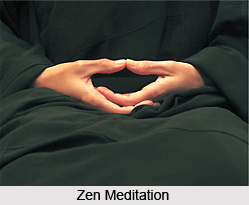 Chair Position - It is also fine to sit in a chair with the feet-resting flat on the floor. One can again use the cushion or zafu, sitting on forward third of it. Alternatively the zafu can be placed at the back. It is very important to keep the spine straight with the lower part of the back curved. All the important aspects when seated on the floor are also useful while sitting on a chair.
Chair Position - It is also fine to sit in a chair with the feet-resting flat on the floor. One can again use the cushion or zafu, sitting on forward third of it. Alternatively the zafu can be placed at the back. It is very important to keep the spine straight with the lower part of the back curved. All the important aspects when seated on the floor are also useful while sitting on a chair.
Procedures of Zen Meditation - The back should be kept straight in Zen Meditation to allow the diaphragm to move freely. The breathing should be very very deep. The abdomen should rise and fall in the same way as an infant`s belly does. In general the breathing become restricted and incomplete with maturity. One tends to make shallow breaths in the upper part of the chest. In the modern days people also wear belts and tight clothing, which refrain one from taking deep and complete breath. So it is important to wear loose outfit while doing Zazen. The clothing should not gather below the knees as it inhibits circulation while seating cross-legged. When the body is in right posture it automatically allows the diaphragm to move freely so that the breathing is deep, easy and natural.
Once the body is positioned properly, the few other things should be kept in notice like mouth should be kept close. Unless there is any kind of nasal blockage one should breath through nose. The tongue is pressed lightly against the upper palate, which cause to reduce the need to salivate and swallow. The eyes are kept lowered, with the gaze fixed on the ground about two or three feet in front of the seating position. The eyes will be mostly covered by the eyelids, which eliminate the necessity to blink repeatedly. The chin is slightly tucked in. Although the whole process looks very disciplined, there should be no tension and all the muscles should be relaxed. The body should be kept straight with the nose centered in line with the naval and the upper torso leaning neither forward nor backward.
The hands should be kept folded in cosmic `mudra`. The thumbs should touch lightly forming an oval, which can rest on the upturned soles of the feet while seated in a full lotus posture. If one is seated in Burmese posture, the hands can rest on thighs. The cosmic mudra tends to turn the attention inward.
The mind should be focused inward. To do this, there are several ways like mind should concentrate at a point of visual image called `Mandalas`. There are also `Mantra` or vocal images. In Zazen there are different types of mudras used in eastern religion. The whole attention is focused on the breath as breath is the central spirit and vital force of the body and it is in union with mind. When the mind is at rest, the breath is deep, easy and effortless.
It is important to centre the attention in the `Hara`, which is a place within the body, located two inches below the navel. Hara is the physical and spiritual centre of the body and in Zazen this serve as centre of attentiveness.
After body and mind is settled in rest, one should start begin rocking the body back and fourth very slowly, in decreasing arcs until the centre of gravity is attained. The attention should be fixed in hara and the breath should be imagined coming down to hara through the viscera and returning back. This should be made as the part of whole cycle of breathing.
The working in Zen Meditation begins with the counting of breath. Each inhalation and exhalation is counted beginning with one up to ten. When ten is reached the counting starts again. This helps to ward off other thoughts from mind. This kind of concentration is called as `Joriki`. Joriki is the centre of martial and visual arts in Zen and is the source of energy of all the activities in our lives.
The Zen Meditation when practiced for a while sharpens the awareness. When counting up to ten is practiced properly, its time to begin counting every cycle of the breath. Inhalation and exhalation together should be counted as one. Eventually one just follows the breath and abandons the counting. At the end the power of concentration ultimately leads to `Samadhi` or single-pointedness of mind.
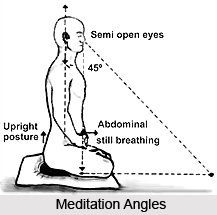 During the practice of Zen Meditation many thoughts comes in mind, especially when one is in crisis. One should let the thoughts to go away automatically and concentrate on breath but one should never use Zazen to suppress the thoughts. After one attains the deep Samadhi at Zazen, he/she breathes at a rate of only two or three breaths at a minute while normally a person breathes fifteen cycles a minute. Respiration, heart rate, Metabolism slows down in Zen Meditation. The whole body comes to a point of stillness that is not reached even in deep sleep. Once one adapts Zazen properly, he/she should practice `Koan` study or `Shikantaza`(just sitting). This should not be looked as gain or promotion. Whatever step is practiced in Zazen, it is performed for complete trance.
During the practice of Zen Meditation many thoughts comes in mind, especially when one is in crisis. One should let the thoughts to go away automatically and concentrate on breath but one should never use Zazen to suppress the thoughts. After one attains the deep Samadhi at Zazen, he/she breathes at a rate of only two or three breaths at a minute while normally a person breathes fifteen cycles a minute. Respiration, heart rate, Metabolism slows down in Zen Meditation. The whole body comes to a point of stillness that is not reached even in deep sleep. Once one adapts Zazen properly, he/she should practice `Koan` study or `Shikantaza`(just sitting). This should not be looked as gain or promotion. Whatever step is practiced in Zazen, it is performed for complete trance.
In Zen Meditation, it is also very important to be patient and persistent. Zazen is practiced for the greater purpose to learn and to uncover mind and to finally see who we really are.

